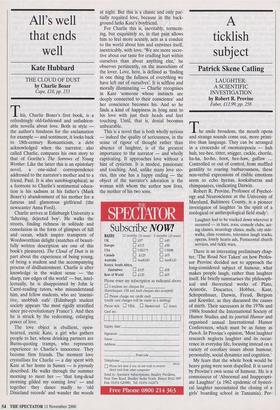A ticklish subject
Patrick Skene Catling
LAUGHTER: A SCIENTIFIC INVESTIGATION by Robert R. Provine Faber, £12.99, pp. 258 The smile broadens, the mouth opens and strange sounds come out, more primi- tive than language. They can be arranged in a crescendo of onomatopoeia — huh huh, tee-hee, titter, snigger, cackle, chortle, ha-ha, ho-ho, hoot, hee-haw, guffaw ... Controlled or out of control, from muffled gentility to roaring barbarousness, these non-verbal expressions of risible emotions seem to echo hyenas, kookaburras and chimpanzees, vindicating Darwin.
Robert R. Provine, Professor of Psychol- ogy and Neuroscience at the University of Maryland, Baltimore County, is a pioneer investigator of laughter 'in the spirit of a zoological or anthropological field study':
Laughter had to be tracked down wherever it occurred — in bars, zoos, comedy clubs, act- ing classes, neurology clinics, malls, city side- walks, class reunions, television laugh tracks, operas, lonely hearts ads, Pentacostal church services, and tickle wars.
There is an interesting preliminary chap- ter, 'The Road Not Taken' on how Profes- sor Provine decided not to approach the long-considered subject of humour, what makes people laugh, rather than laughter itself. He briefly summarises the philosoph- ical and theoretical works of Plato, Aristotle, Descartes, Hobbes, Kant, Schopenhauer, Darwin, Freud, Bergson and Koestler, as they discussed the causes of mirth. Their successors in the 1970s and 1980s founded the International Society of Humor Studies and its journal Humor and organised annual International Humor Conferences, which must be as funny as Punch. In Provine's opinion, 'Most laughter research neglects laughter and its occur- rence in everyday life, focusing instead on a variety of corollary issues about humour, personality, social dynamics and cognition.'
My fears that the whole book would be heavy going were soon dispelled. It is saved by Provine's own sense of humour. He is a connoisseur of 'Abnormal and Inappropri- ate Laughter' (a 1962 epidemic of hysteri- cal laughter necessitated the closing of a girls' boarding school in Tanzania). Per- haps he can be forgiven for a couple of his puns, perhaps not: he calls moving on to the next joke too quickly 'premature ejoku- lation', leading to `laftus interruptus'. Sorry, I just had to tell someone.
In the book's academically, technologi- cally most substantial chapter, 'Cracking the Laugh Code: From Sound Lab to Opera Studio', Provine writes of laughter as a means of universal communication and of his use of 'a sound analyser to generate detailed graphic and numerical descrip- tions of sound frequency and amplitude' of `a hard-won sample of 51 laugh recordings'.
Guffaws, chuckles and giggles are not arbi- trary sounds, but types of innate acoustic code that have priority access to our brains and trigger behaviour. Barriers between cul- tures and races fall away when we use this ancient signal, a sound more like an animal call or cry than human speech.
There are laughter graphs derived from a sound spectrograph, showing, for example, the 'frequency spectrum of a six-note ha-ha laugh from an adult male'. The researchers found 'common features that we all share', `from infancy to old age, whether Manhat- tanite or Zulu'. But Provine also sought `the bizarre-sounding laughs' of individuals `whose vocal trumpeting pushes the enve- lope of weirdness'. No club is quite safe.
For the lay reader, the most enlightening chapter of all is the one on 'Ticklish Rela- tionships', for 'tickling', the good professor points out,
is not a footnote in the story of laughter but at the very heart of it... Tickle and associated rowdy play are the main sources of laughter in our primate relatives and are the ancestral stimuli for laughter.
Tickling starts in the cradle and continues, though diminishing, as long as life lasts.
Attempts have been made to measure ticklishness. Lawrence Weiskranzt and col- leagues 'devised a manually operated tickle machine to explore why you can't tickle yourself. Sarah-Jayne Blakemore and col- leagues used a robotic tickler controlled by a computer. As Provine sums up the mechanical findings: The stimulus cancellation that prevents self- stimulation is minimal with zero delay or tra- jectory perturbation and increased up to a point (1/5 second or 90 degrees) when the sensation becomes indistinguishable from an externally produced sensation.
Tickle is the tenth of Provine's 'Ten Tips for Increasing Laughter', 'the most potent, ancient and controversial laugh-stimulus'.
Tickling is controversial because a tickle too many can kill. Provine reminds us that Simon de Montfort executed some captives by tickling the soles of their feet with a feath- er. The ultimate cause of death in such cases is unknown, but the sustained, uncontrollable laughter and struggling of the victim may cause cardiac arrest or cerebral haemor- rhage.
But laugh and the world laughs with you. In the words of the song, 'Don't worry. Be happy.'



























































































 Previous page
Previous page